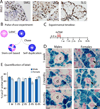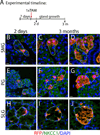Salivary gland homeostasis is maintained through acinar cell self-duplication
- PMID: 25843887
- PMCID: PMC4406828
- DOI: 10.1016/j.devcel.2015.02.013
Salivary gland homeostasis is maintained through acinar cell self-duplication
Abstract
Current dogma suggests that salivary gland homeostasis is stem cell dependent. However, the extent of stem cell contribution to salivary gland maintenance has not been determined. We investigated acinar cell replacement during homeostasis, growth, and regeneration, using an inducible CreER(T2) expressed under the control of the Mist1 gene locus. Genetic labeling, followed by a chase period, showed that acinar cell replacement is not driven by the differentiation of unlabeled stem cells. Analysis using R26(Brainbow2.1) reporter revealed continued proliferation and clonal expansion of terminally differentiated acinar cells in all major salivary glands. Induced injury also demonstrated the regenerative potential of pre-labeled acinar cells. Our results support a revised model for salivary gland homeostasis based predominantly on self-duplication of acinar cells, rather than on differentiation of stem cells. The proliferative capacity of differentiated acinar cells may prove critical in the implementation of cell-based strategies to restore the salivary glands.
Copyright © 2015 Elsevier Inc. All rights reserved.
Conflict of interest statement
The authors declare no conflict of interest.
Figures




References
-
- Dardick I, Burford-Mason AP. Current status of histogenetic and morphogenetic concepts of salivary gland tumorigenesis. Critical reviews in oral biology and medicine : an official publication of the American Association of Oral Biologists. 1993;4:639–677. - PubMed
-
- Denny PC, Denny PA. Dynamics of parenchymal cell division, differentiation, and apoptosis in the young adult female mouse submandibular gland. Anatomical Record. 1999;254:408–417. - PubMed
Publication types
MeSH terms
Substances
Grants and funding
LinkOut - more resources
Full Text Sources
Other Literature Sources
Molecular Biology Databases

